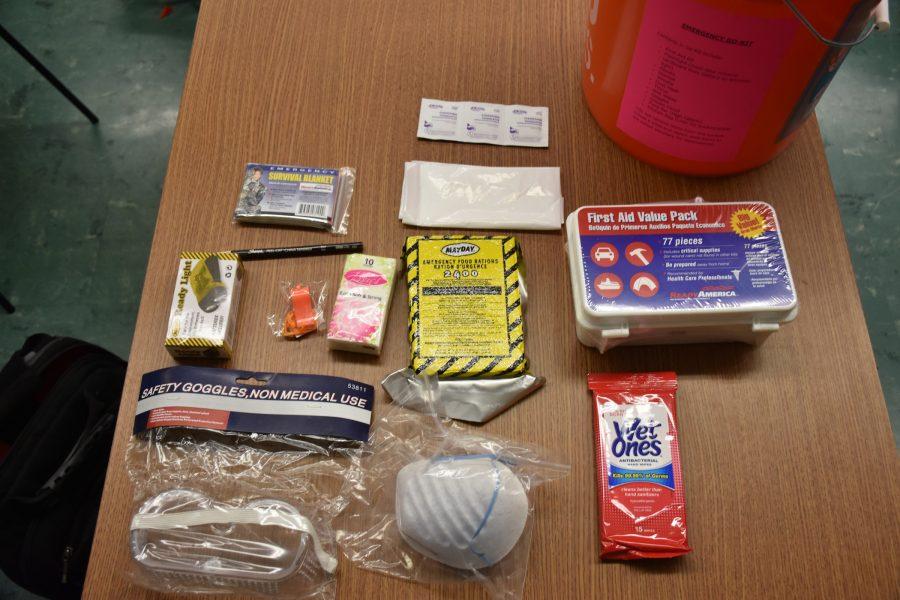Orange bucket list? More supplies, training
They can be found in every classroom in Portland Public Schools: orange emergency supply buckets.
Intended as a source of life-saving supplies in the event of a disaster, they instead seem to hold little actual help.
In fact, the buckets generally appear to only have the ability to sustain one to two Cardinals for a few hours. In one case it contained one foil emergency blanket, one food bar and a several other non-essential items. The containers did not have any water or means to obtain water.
What’s going on?
According to PPS Emergency Preparedness Manager Molly Emmons, the program requires participation by the school, which, based on the several Lincoln buckets surveyed by the Cardinal Times, Lincoln has not conducted.
According to Emmons, this is the limit of what the district can provide. Individual schools are meant to “augment” the initial supplies.
“The intent isn’t to sustain students for days and days on end, it’s more to get schools to start thinking and planning ahead.”
In some schools, “it’s been very effective,” she said, as PTAs and student clubs like Red Cross Club have run drives to buy additional supplies for the buckets, especially water. Water is difficult for the district to provide because it takes up large amounts of space and expires.
That’s why Emmons recommends it as one of the first items schools should add. “The buckets can hold several bottles of water and then at the end of the school year, you can take the water out and drink it.”
Lincoln’s Red Cross Club is planning a project related to emergency preparedness in January, according its volunteer manager, junior Kelly Ryu.
Emmons says the orange buckets, which were funded by a 2010 federal grant, have come into use before. “An elementary school in North Portland was evacuated and the buckets turned into toilets for the little kids using the (garbage) bag [included in it],” she says, “and people have used the flashlights.”
As well as the buckets, Emmons says her small office (a single-woman operation) is maximizing its small budget on several projects related to preparedness. These programs can help make the buckets more effective in a disaster.
Wilson High School this year is piloting Community Emergency Response class, a semester-long course in disaster response. Emmons hopes it can be rolled out across the district’s high schools by 2022. She is also running a non-structural hazard mitigation program, which aims to remove items that could fall on students in an earthquake.
In addition, she is hoping to get train some staff at every school in ametuer radio operation so that they can communicate in an emergency. Finally, Emmons is exploring placing shipping containers at each school to supplement the supplies in the orange buckets.
But she still needs the help of students and staff for these projects and the buckets to be truly effective.
“Talk about preparedness with your family. Think of the what ifs, [such as] if you were stuck in your car, do you have food and water, small stuff,” she says.
She has helped organize several Youth Disaster Academies, in which sophomores and juniors learned disaster response, including search and rescue, fire suppression and CPR.
“Especially at the high school level, trained students can be a great asset for emergency responders,” she said. “Students are our future and the more prepared they are, the better off we’re all going to be.”
The orange buckets may appear at first to be a feeble attempt at preparing for a major disaster, but, combined with other programs and initiative from the school to supplement the initial supplies, they could save lives.
—
Recommended supplies for personal emergency kit
(place a kit in your home, car, maybe locker)
- Water, one gallon of water per person per day for at least three days, for drinking and sanitation
- Food, at least a three-day supply of non-perishable food
- Battery-powered or hand crank radio and a NOAA Weather Radio with tone alert and extra batteries for both
- Flashlight and extra batteries
- First aid kit
- Whistle to signal for help
- Dust mask to help filter contaminated air and plastic sheeting and duct tape to shelter-in-place
- Moist towelettes, garbage bags and plastic ties for personal sanitation
- Wrench or pliers to turn off utilities
- Manual can opener for food
- Local maps
- Cell phone with chargers, inverter or solar charger
Source: FEMA


Jill Ross • Dec 22, 2016 at 9:45 am
Our orange buckets are only part of our emergency plans. Supplies are kept in 104, main office and nurses office to supplement the basics in the buckets. We are constantly re-evaluating our emergency needs. The recent snow storm made us realize battery powered phone chargers and Android and iPhone chargers were needed as well. VP Alfredo Quintero is in charge of our safety committee and can help with more answers about out safety plans.